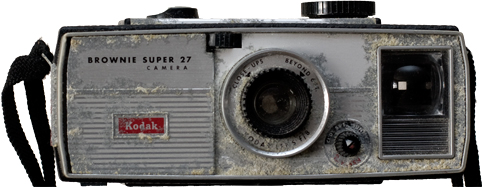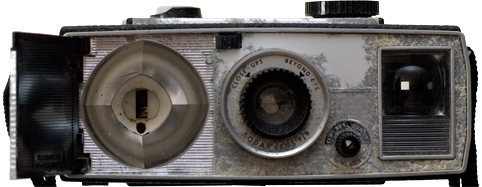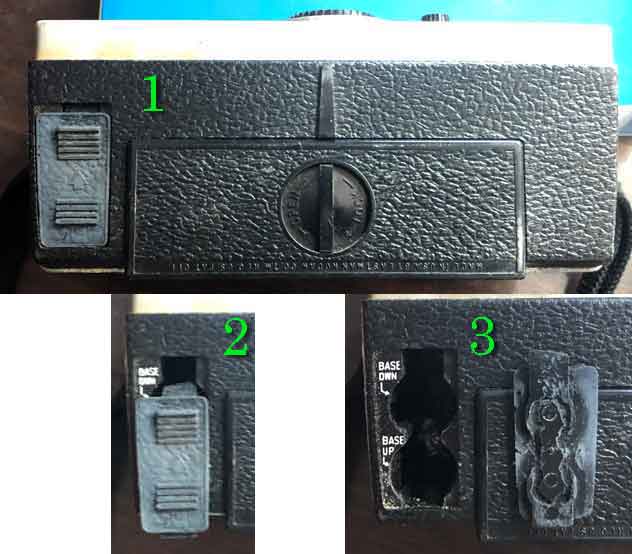Approx. dates of manufacture: 1961 -1965
Battery: two AA cells
Approx. original price: $19
Approx. street value: $1
This amazes me: I was writing up a camera test in Modern Photography magazine for another camera, and right next to it, they reviewed this camera, a Brownie. Modern normally reviews middle and high-end cameras, not plastic snapshooters.


I had bought this as a kid; it was one of the first dozen or so, from a thrift shop. The door on the left side (as you look at the front of the cameras) is spring loaded, so you can flip it open and put a peanut flash bulb in it. I thought that was slick.
But it took 127 film, which was hard to get even then, and it's plastic and it looks like a toy, and even as a kid I rapidly got to the point where I saw that it wasn't much account. So it went into a box with the rest of my collection.
Somewhere along the line it got water damage. The interior of the case disintegrated and fused with the body, so you can see a lot of residual corrosion here. Doesn't seem to have affected anything other than the cosmetics, however.
Here's the Modern review, in its entirety. It was written by the late, great Herb Heppler.
No, dear reader, we haven't gone out of our minds testing what seems to be nothing more than a sleek updated box camera. This is a real wolf in sheep's clothing, a sleeper, if you will.
When the Brownie Super 27 is used carefully, the big improved Ektachrome slides it produces are virtually indistiguisable from those made by first-class twin-lens reflexes with a precision 4-element Tessar-type lens.
You'll find that the unmarked lens has two positions, "close-ups" and "beyond 6 ft." There is also a knob marked "Sunny," "Cloudy Bright" and "Flash" that the advanced among us will probably recognize as an aperture control. The "close-ups" setting is actually 5.5 ft. while the "beyond 6 ft." setting is 16 ft. The "Flash" and "Cloudy Bright" markings are actually f/3 and the sunny marking is f/13.5. Shutter speed is 1/80 sec., but you can set a 1/40 sec by opening up the flash reflector door. With due care for depth-of-field at the two apertures and focusing distances, and proper regard for the limitations on subject movement inherent at 1/40 and 1/80 sec., you can make this camera do wonders.
Part of the credit must go to the 3-ement plastic lens. As you may know, plastic lenses can be turned out in quantity with virtually no deviation in quality, no difference between one lens and the next. Unfortunately, it's not yet possible to make them for large apertures, so don't expect to replace your f/1.8 or f/2 lens with a plastic one for some time.
Another problem is that the anti-reflection coatings don't take to plastic lenses. Hence only the simplest lenses with the minimum number of surfaces can be made using plastic successfully. (Hint: in using the Brownie Super 27, keep the lens well shaded and avoid any shiny objects which might cause flary reflections).
The Brownie Super 27 itself has a plastic body with a finish which is remarkably close to a leather texture. The braided nylon carrying cord is a lot stronger and will last longer than many of the leather ones furned on expensive cameras, and the satin chrome of the front panel is a lot smoother than that found on many high-priced machines. The rapid wind knob's big and not just what you might call super-smooth in action. On the other hand, the shutter release is super-larger, well contoured and much better than can be found etc., etc.
Once you get over having a camera shaped like a pound block of butter, you'll find this Brownie easy to hold. In addition, the built-in reflector is really pretty zippy. You can keep a bulb in it. The bulb will not go off when the shutter release is pressed unless you first press the latch that swings open the front reflector door. This can come as quite a surprise to those not expecting a flash blash—something like squirting an April fool victim with water from an artificial buttonhole rose. (Kodak provides a flexible plastic shield to fit over the reflector for those who feel nervous about bulb explosions.) There's a spring-loaded bulb ejector switch on the camera back.
In short, if you don't mind the rather limited speeds, apertures and focusing ranges plus lack of any focusing device such as rangefinder or ground glass, we can see no reason for you to buy a more expensive camera than this. Of course you will have to wind film watching numbers in the ruby window at the back, the camera does not provide interchangeability of lenses, you can't hook it to electronic flash and no provision is made for parallax correction.
Color slides made with improved Ektachrome in normal outdoor lighting conditions indicate that this f/8 Kodar lens is quite good for snapshot picture making.
This may give readers suffering from overcomplication of their equipment some food for thought.
A reader asked me about the little sliding door on the bottom of the camera. This is the battery compartment door. If you look at the instruction manual, there is no mention whatsoever of batteries, even though they do mention that the camera takes AG5 flash bulbs. This camera uses two AA batteries. See the photo underneath.

It's very possible that the door will be stuck shut if old batteries were left inside and leaked, in which case you will have to try and prise it open with a penknife or a flat-blade screwdriver. Slide the door in the direction of the arrow, it should go about 1/16th inch, then slip something underneath the back and try to lift it open. Go easy. Old battery acid sticks things down but it's not superglue.
I have no idea why they didn't mention batteries in the owner's manual.
Camera manual: Orphan Cameras.com
Modern Photography magazine camera test: March 1962


